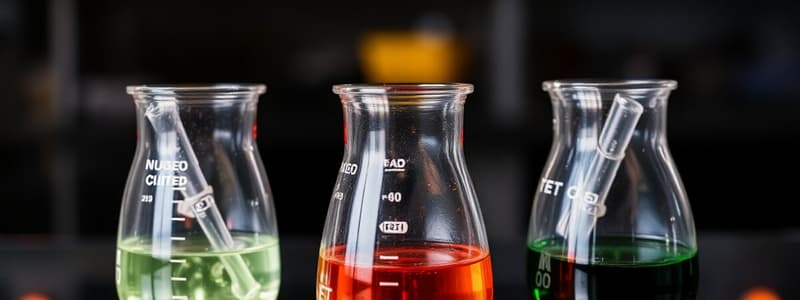Podcast
Questions and Answers
In a redox reaction, if a chemical species is said to be reduced, which of the following processes has occurred?
In a redox reaction, if a chemical species is said to be reduced, which of the following processes has occurred?
- It has neither gained nor lost electrons, but changed its physical state.
- It has gained electrons from another species. (correct)
- It has facilitated the oxidation of another species but remains unchanged.
- It has lost electrons to another species.
Which statement accurately differentiates between voltaic and electrolytic cells?
Which statement accurately differentiates between voltaic and electrolytic cells?
- Voltaic cells use a salt bridge, while electrolytic cells use a porous cup to maintain electrical neutrality.
- Voltaic cells require an external energy source, while electrolytic cells produce energy spontaneously.
- Voltaic cells produce energy from spontaneous reactions, while electrolytic cells require energy to drive non-spontaneous reactions. (correct)
- Voltaic cells facilitate reduction at the anode, while electrolytic cells facilitate oxidation at the cathode.
If a metal corrodes, what type of chemical reaction is primarily responsible for this process?
If a metal corrodes, what type of chemical reaction is primarily responsible for this process?
- A reaction involving only the physical change of state of the metal.
- A redox reaction where the metal returns to its ore state. (correct)
- A disproportionation reaction where the metal is both oxidized and reduced.
- A non-redox reaction that changes the metal's appearance.
In an electrochemical cell, what is the primary function of a salt bridge or porous cup?
In an electrochemical cell, what is the primary function of a salt bridge or porous cup?
Which of the following statements is true regarding oxidizing and reducing agents in a redox reaction?
Which of the following statements is true regarding oxidizing and reducing agents in a redox reaction?
What is the significance of the electrode at which reduction occurs in an electrochemical cell, and what is its standard designation?
What is the significance of the electrode at which reduction occurs in an electrochemical cell, and what is its standard designation?
Consider the half-reaction: $Zn(s) \rightarrow Zn^{2+}(aq) + 2e^-$. Is this an oxidation or reduction half-reaction, and how can you tell?
Consider the half-reaction: $Zn(s) \rightarrow Zn^{2+}(aq) + 2e^-$. Is this an oxidation or reduction half-reaction, and how can you tell?
In a redox table, how are the strongest oxidizing agent (SOA) and the strongest reducing agent (SRA) typically positioned?
In a redox table, how are the strongest oxidizing agent (SOA) and the strongest reducing agent (SRA) typically positioned?
Flashcards
Redox Reaction
Redox Reaction
A reaction where electrons are transferred between chemical species, involving oxidation and reduction.
Oxidation
Oxidation
The loss of electrons by a species in a chemical reaction.
Reduction
Reduction
The gain of electrons by a species in a chemical reaction.
Oxidizing Agent (OA)
Oxidizing Agent (OA)
Signup and view all the flashcards
Reducing Agent (RA)
Reducing Agent (RA)
Signup and view all the flashcards
Disproportionation Reaction
Disproportionation Reaction
Signup and view all the flashcards
Cathode
Cathode
Signup and view all the flashcards
Anode
Anode
Signup and view all the flashcards
Study Notes
- Redox Reaction: Involves the transfer of electrons between chemical species, characterized by oxidation and reduction processes.
Half Reaction
- Represents either the oxidation or the reduction part of a redox reaction, examined separately.
Oxidation
- The loss of electrons by a species during a chemical reaction.
Electrochemistry
- The study of redox reactions and the phenomena of electron transfer.
Disproportionation Reaction
- A reaction where a single species undergoes both oxidation and reduction simultaneously.
Reduction
- The gain of electrons by a species during a chemical reaction.
LEO
- Acronym for "Loss of Electrons is Oxidation," a mnemonic to remember oxidation.
GER
- Acronym for "Gain of Electrons is Reduction," a mnemonic to remember reduction.
Oxidizing Agent (OA)
- The species that facilitates oxidation in a reaction by accepting electrons.
Reducing Agent (RA)
- The species that facilitates reduction in a reaction by donating electrons.
Non-Redox Reaction
- A reaction in which no electron transfer occurs between the reactants.
Change in State
- Indicates a redox reaction when ions are formed.
Ionic Compounds
- Compounds formed through the transfer of electrons, resulting in the creation of ions.
Spectators
- Species or ions that are present in a reaction but do not participate in the electron transfer process.
Water Formation
- The combination of H+ and OH- ions to produce H2O molecules.
Oxidation Half Reaction
- Characterized by electrons appearing as products in the reaction.
Reduction Half Reaction
- Characterized by electrons appearing as reactants in the reaction.
Forward Reaction
- The reaction direction that leads to the formation of products from reactants.
Spontaneous Reactions
- Reactions that proceed without the need for additional energy input.
Non-Spontaneous Reactions
- Reactions that require external energy to occur.
Strongest Oxidizing Agent (SOA)
- Located at the top left of a redox table.
Strongest Reducing Agent (SRA)
- Located at the bottom right of a redox table.
Spontaneity Rule
- Used to determine whether a reaction will proceed without any external energy input.
Half-Cell Reaction
- Represents either the oxidation or reduction process occurring at an electrode in electrochemistry.
Primary Standard
- A substance available in a stable and pure state, can be directly used to prepare a standard solution.
Voltaic Cells
- Electrochemical cells that produce energy through spontaneous chemical reactions.
Electrolytic Cells
- Electrochemical cells that require energy to drive non-spontaneous reactions.
Electrolyte
- An aqueous solution containing ions that enables electrical conduction.
Electrode
- A solid electrical conductor that boosts redox reactions.
Half Cell
- An electrode immersed in an electrolyte solution where redox reactions occur.
Cathode
- The positive electrode where reduction occurs in an electrochemical cell.
Anode
- The negative electrode where oxidation occurs in an electrochemical cell.
Phase Boundary
- The separation between the solid electrode and the liquid electrolyte in a cell.
Salt Bridge
- A component used to maintain electrical neutrality within electrochemical cells.
Porous Cup
- A container that allows ion movement between solutions without the use of a salt solution.
Cell Potential
- The difference in reduction potentials between two half-cells, determining the voltage of the cell.
Corrosion
- A redox reaction where a metal returns to its ore state.
Oxide Coating
- A protective layer formed on metals that preserves the remaining metal from corrosion.
Iron Corrosion
- A specific spontaneous reaction of iron with water and oxygen.
Rust
- Iron (III) oxide hydrates that are formed as a result of iron corrosion.
Flaking
- The detachment of rust from iron, exposing fresh iron to further corrosion.
Protective Coatings
- Barriers applied to metals to prevent contact with oxygen and water, thus preventing corrosion.
Galvanization
- The process of coating iron with zinc to protect it from corrosion.
Cathodic Protection
- Preventing iron degradation by making it the cathode in an electrochemical cell.
Impressed Current
- The method of electrically forcing electron flow through iron to prevent corrosion.
Sacrificial Anode
- A stronger reducing agent connected to iron to protect it from degradation by corroding instead.
Electric Cell
- A device that converts chemical energy into electrical energy.
Studying That Suits You
Use AI to generate personalized quizzes and flashcards to suit your learning preferences.




